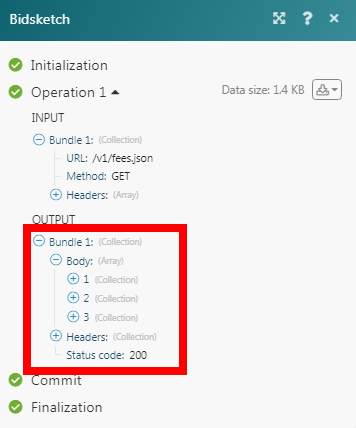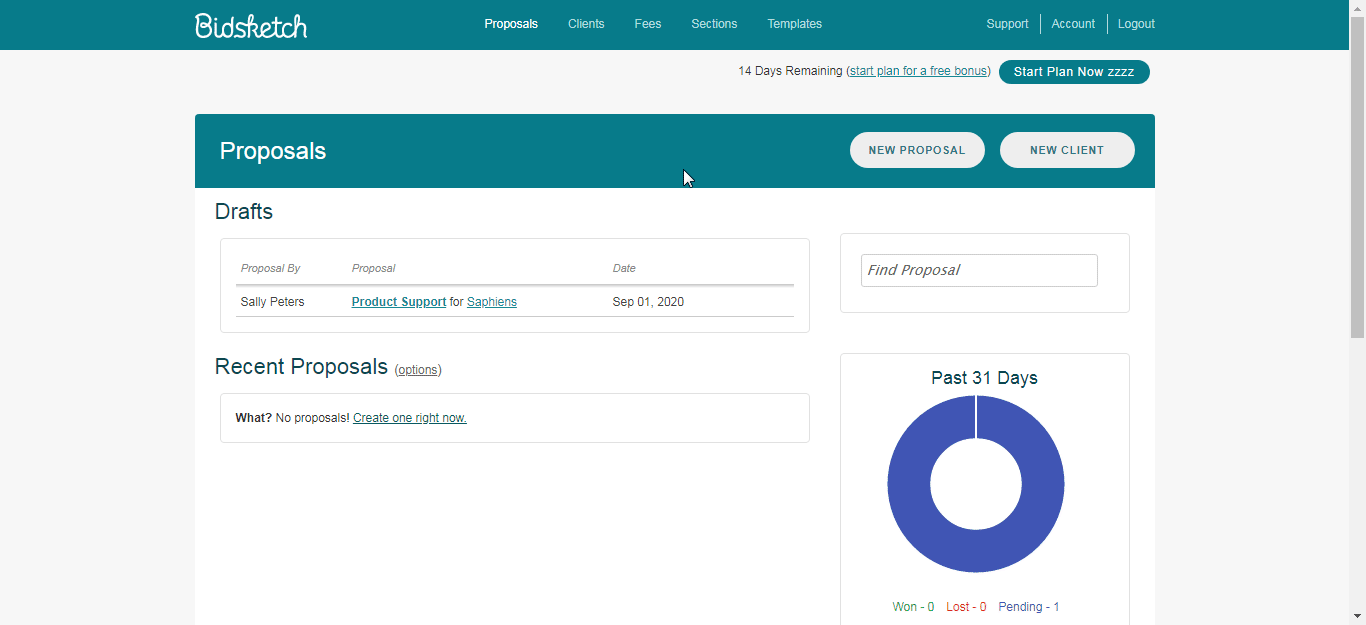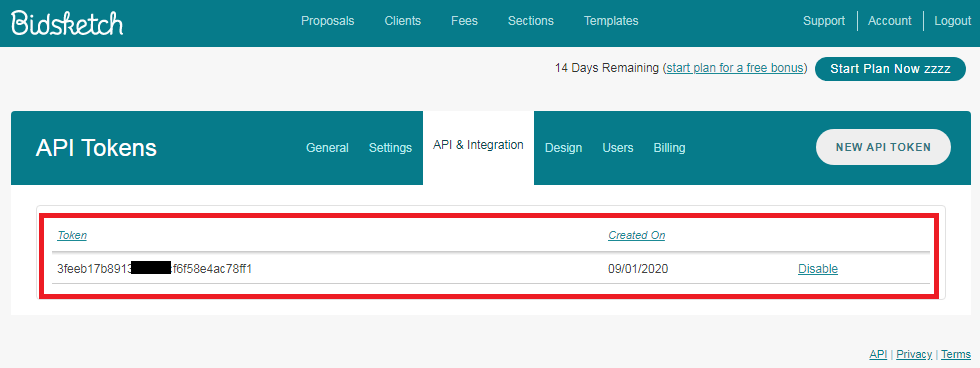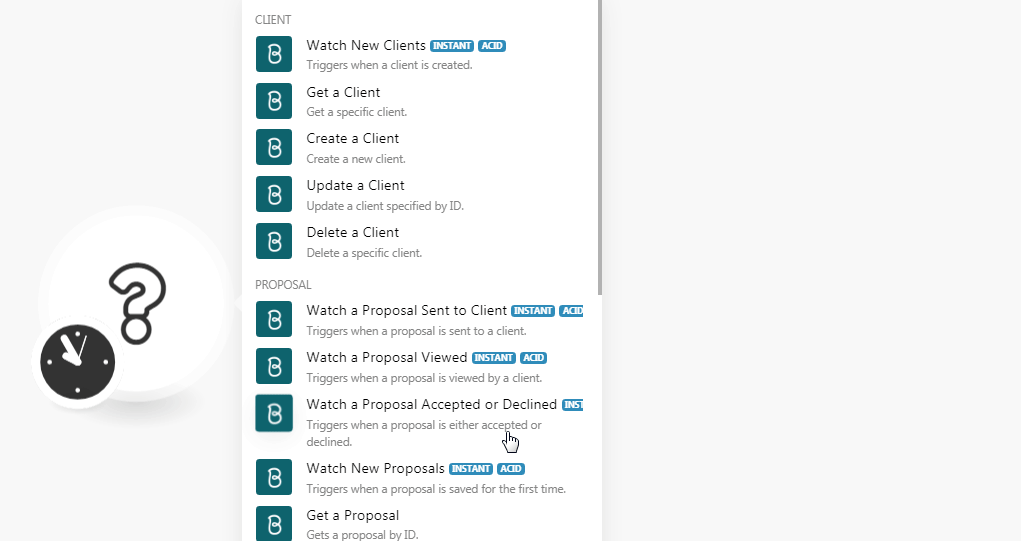| Active with remarks |
|---|
| This application needs additional settings. Please follow the documentation below to create your own connectionUnique, active service acces point to a network. There are different types of connections (API key, Oauth…). More. |
The Bidsketch moduleThe module is an application or tool within the Boost.space system. The entire system is built on this concept of modularity. (module - Contacts) More allows you to create, update, retrieve, and delete proposals, and fees in your Bidsketch account.
Prerequisites
-
A Bidsketch account
In order to use Bidsketch with Boost.spaceCentralization and synchronization platform, where you can organize and manage your data. More IntegratorPart of the Boost.space system, where you can create your connections and automate your processes. More, it is necessary to have a Bidsketch account. If you do not have one, you can create a Bidsketch account at signup.bidsketch.com/signup/bidsketch.
To connect your Bidsketch account to Boost.space Integrator you need to obtain the API Key from your Bidsketch account and insert it in the Create a connection dialog in the Boost.space Integrator module.
-
Log in to your Bidsketch account.
-
Click Accounts > API & Integration > Unique TokenThe API token is a multi-digit code that allows a user to authenticate with cloud applications. More.
-
Copy the token to your clipboard.
-
Go to Boost.space Integrator and open the Bidsketch module’s Create a connection dialog.
-
In the Connection name field, enter a name for the connection.
-
In the API Key field, enter the token copied in step 3 and click Continue.
The connection has been established.
TriggersEvery scenario has a trigger, an event that starts your scenario. A scenario must have a trigger. There can only be one trigger for each scenario. When you create a new scenario, the first module you choose is your trigger for that scenario. Create a trigger by clicking on the empty module of a newly created scenario or moving the... when a new client is created.
![[Note]](https://docs.boost.space/wp-content/themes/bsdocs/docs-parser/HTML/css/image/note.png) |
Note |
|---|---|
|
You do not have to add the webhooksA webhook is a way for an app to send real-time information to a specific URL in response to certain events or triggers. in the Bidsketch as it is automatically done for you once you add and save an instant triggerEvery scenario has a trigger, an event that starts your scenario. A scenario must have a trigger. There can only be one trigger for each scenario. When you create a new scenario, the first module you choose is your trigger for that scenario. Create a trigger by clicking on the empty module of a newly created scenario or moving the... module to your scenario. |
|
WebhookA webhook is a way for an app to send real-time information to a specific URL in response to certain events or triggers. Name |
Enter a name for the webhook. |
|
Connection |
Gets a specific client.
|
Connection |
|
|
Client ID |
Select the Client ID whose details you want to retrieve. |
Create a new client.
|
Connection |
|
|
First Name |
Enter the first name of the client. |
|
Last Name |
Enter the last name of the client. |
|
Email Address |
Enter the email address of the client. |
|
Name |
Enter the name of the client. |
|
Phone |
Enter the phone number of the client. |
|
Alt Phone |
Enter any alternate phone number of the client. |
|
Website |
Enter the client’s website URL address. |
|
Address Field One |
Enter the street address of the client. |
|
Address Field Two |
Enter the street address of the client. |
|
City |
Enter the client’s city name. |
|
State |
Enter the client’s state name. |
|
Postal Zip |
Enter the client’s area postal zip code. |
|
Country |
Enter the client’s country name. |
|
Notes |
Enter any additional information about the client. |
|
Other Contact |
Enter an alternative client’s contact address. |
Update a client as specified by ID.
|
Connection |
|
|
First Name |
Enter the first name of the client. |
|
Last Name |
Enter the last name of the client. |
|
Email Address |
Enter the email address of the client. |
|
Name |
Enter the name of the client. |
|
Phone |
Enter the phone number of the client. |
|
Alt Phone |
Enter any alternate phone number of the client. |
|
Website |
Enter the client’s website URL address. |
|
Address Field One |
Enter the street address of the client. |
|
Address Field Two |
Enter the street address of the client. |
|
City |
Enter the client’s city name. |
|
State |
Enter the client’s state name. |
|
Postal Zip |
Enter the client’s area postal zip code. |
|
Country |
Enter the client’s country name. |
|
Notes |
Enter any additional information about the client. |
|
Other Contact |
Enter an alternative client’s contact address. |
Deletes a specific client.
|
Connection |
|
|
Client ID |
Select the Client ID you want to delete. |
Triggers when a proposal is sent to a client.
![[Note]](https://docs.boost.space/wp-content/themes/bsdocs/docs-parser/HTML/css/image/note.png) |
Note |
|---|---|
|
You do not have to add the webhooks in the Bidsketch as it is automatically done for you once you add and save an instant trigger module to your scenario. |
|
Webhook Name |
Enter a name for the webhook. |
|
Connection |
Triggers when a proposal is viewed by the client.
![[Note]](https://docs.boost.space/wp-content/themes/bsdocs/docs-parser/HTML/css/image/note.png) |
Note |
|---|---|
|
You do not have to add the webhooks in the Bidsketch as it is automatically done for you once you add and save an instant trigger module to your scenario. |
|
Webhook Name |
Enter a name for the webhook. |
|
Connection |
Triggers when a proposal is either accepted or declined.
![[Note]](https://docs.boost.space/wp-content/themes/bsdocs/docs-parser/HTML/css/image/note.png) |
Note |
|---|---|
|
You do not have to add the webhooks in the Bidsketch as it is automatically done for you once you add and save an instant trigger module to your scenario. |
|
Webhook Name |
Enter a name for the webhook. |
|
Connection |
Triggers when a proposal is saved for the first time.
![[Note]](https://docs.boost.space/wp-content/themes/bsdocs/docs-parser/HTML/css/image/note.png) |
Note |
|---|---|
|
You do not have to add the webhooks in the Bidsketch as it is automatically done for you once you add and save an instant trigger module to your scenario. |
|
Webhook Name |
Enter a name for the webhook. |
|
Connection |
Gets Proposal by ID.
|
Connection |
|
|
Proposal ID |
Select the Proposal ID whose details you want to retrieve. |
Creates a proposal for a specific client.
|
Connection |
|
|
Client ID |
Select the Client ID for whom you are creating the proposal. |
|
Name |
Enter a name for the proposal. |
|
Description |
Enter the details of the project. |
|
Currency |
Select the applicable currency for the proposal. |
|
Proposal Date |
Enter the date on which you are creating this proposal. |
|
Tax |
Enter the tax applicable to the proposal in percentage. For example, |
|
Tax 2 |
Enter any other additional tax applicable to the proposal in percentage. For example, |
|
Discount |
Enter the discount applicable to the proposal in percentage. For example, |
|
Provide Proposal Settings |
Select whether to provide proposal settings:
|
|
Proposal Fees Title |
Enter a name for the proposal fees. |
|
Approval Message |
Enter the message to be sent to the client on approving the proposal. |
|
Optional Fees Note |
Enter the note for the optional fees. |
|
Optional Fees Title |
Enter a name for the optional fees. |
|
Include Optional Fees In Totals |
Select whether to include the optional fees in the proposal total amount:
|
|
Hide Monthly Total |
Select whether to hide the monthly total amount:
|
|
Hide Project Total |
Select whether to hide the monthly total amount:
|
|
Hide Yearly Total |
Select whether to hide the yearly total amount:
|
|
Hide Grand Total |
Select whether to hide the grand total amount:
|
Creates a proposal from the selected templateTemplates are predefined scenarios that you can expand and customize to create new scenarios. You can then share these with friends and colleagues. More.
|
Connection |
|
|
Template ID |
Select the Template ID for the proposal you want to create. |
|
Client ID |
Select the Client ID for whom you are creating the proposal. |
|
Name |
Enter a name for the proposal. |
|
Description |
Enter the details of the project. |
|
Currency |
Select the applicable currency for the proposal. |
|
Proposal Date |
Enter the date on which you are creating this proposal. |
|
Tax |
Enter the tax applicable to the proposal in percentage. For example, |
|
Tax 2 |
Enter any other additional tax applicable to the proposal in percentage. For example, |
|
Discount |
Enter the discount applicable to the proposal in percentage. For example, |
|
Provide Proposal Settings |
Select whether to provide proposal settings:
|
|
Proposal Fees Title |
Enter a name for the proposal fees. |
|
Approval Message |
Enter the message to be sent to the client on approving the proposal. |
|
Optional Fees Note |
Enter the note for the optional fees. |
|
Optional Fees Title |
Enter a name for the optional fees. |
|
Include Optional Fees In Totals |
Select whether to include the optional fees in the proposal total amount:
|
|
Hide Monthly Total |
Select whether to hide the monthly total amount:
|
|
Hide Project Total |
Select whether to hide the monthly total amount:
|
|
Hide Yearly Total |
Select whether to hide the yearly total amount:
|
|
Hide Grand Total |
Select whether to hide the grand total amount:
|
Updates a proposal specified by ID.
|
Connection |
|
|
Proposal ID |
Select the Proposal ID whose details you want to update. |
|
Client ID |
Select the Client ID for whom you are creating the proposal. |
|
Name |
Enter a name for the proposal. |
|
Description |
Enter the details of the project. |
|
Currency |
Select the applicable currency for the proposal. |
|
Proposal Date |
Enter the date on which you are creating this proposal. |
|
Tax |
Enter the tax applicable on the proposal in percentage. For example, |
|
Tax 2 |
Enter any other additional tax applicable to the proposal in percentage. For example, |
|
Discount |
Enter the discount applicable to the proposal in percentage. For example, |
|
Approval Message |
Enter the message to be sent to the client on approving the proposal. |
|
Optional Fees Note |
Enter the note for the optional fees. |
|
Optional Fees Title |
Enter a name for the optional fees. |
|
Proposal Fees Title |
Enter a name for the proposal fees. |
|
Include Optional Fees In Totals |
Select whether to include the optional fees in the proposal total amount:
|
|
Hide Monthly Total |
Select whether to hide the monthly total amount:
|
|
Hide Project Total |
Select whether to hide the monthly total amount:
|
|
Hide Yearly Total |
Select whether to hide the yearly total amount:
|
|
Hide Grand Total |
Select whether to hide the grand total amount:
|
Deletes a proposal specified by ID.
|
Connection |
|
|
Proposal ID |
Select the Proposal ID you want to delete. |
Gets a fee specified by ID.
|
Connection |
|
|
Fee ID |
Select the Fee ID whose details you want to retrieve. |
Creates a new fee.
|
Connection |
|
|
Name |
Enter a name for the fee. |
|
Amount |
Enter the amount for the fee. |
|
Fee Type |
Select the fee type:
|
|
Unit |
Enter the unit of the fee. Applicable only if you have selected the Fee Type as Custom. For example, |
|
Quantity |
Enter the quantity used for calculating the fees. |
|
Category |
Enter the fee category to group the fees together. |
|
Description |
Enter the details of the fee. |
Updates a fee specified by ID.
|
Connection |
|
|
Fee ID |
Select the Fee ID whose details you want to update. |
|
Name |
Enter a name for the fee. |
|
Amount |
Enter the amount for the fee. |
|
Fee Type |
Select the fee type:
|
|
Unit |
Enter the unit of the fee. Applicable only if you have selected the Fee Type as Custom. For example, |
|
Quantity |
Enter the quantity used for calculating the fees. |
|
Category |
Enter the fee category to group the fees together. |
|
Description |
Enter the details of the fee. |
Deletes a fee specified by ID.
|
Connection |
|
|
Fee ID |
Select the Fee ID you want to delete. |
Performs an arbitrary authorized API call.
|
Connection |
||||
|
URL |
Enter a path relative to
|
|||
|
Method |
Select the HTTP method you want to use: GET to retrieve information for an entry. POST to create a new entry. PUT to update/replace an existing entry. PATCH to make a partial entry update. DELETE to delete an entry. |
|||
|
Headers |
Enter the desired request headers. You don’t have to add authorization headers; we already did that for you. |
|||
|
Query String |
Enter the request query string. |
|||
|
Body |
Enter the body content for your API call. |
The following API call returns all the fees from your Bidsketch account:
URL:
/v1/fees.json
Method:
GET

Matches of the search can be found in the module’s Output under BundleA bundle is a chunk of data and the basic unit for use with modules. A bundle consists of items, similar to how a bag may contain separate, individual items. More > Body.
In our example, 3 fees were returned:




